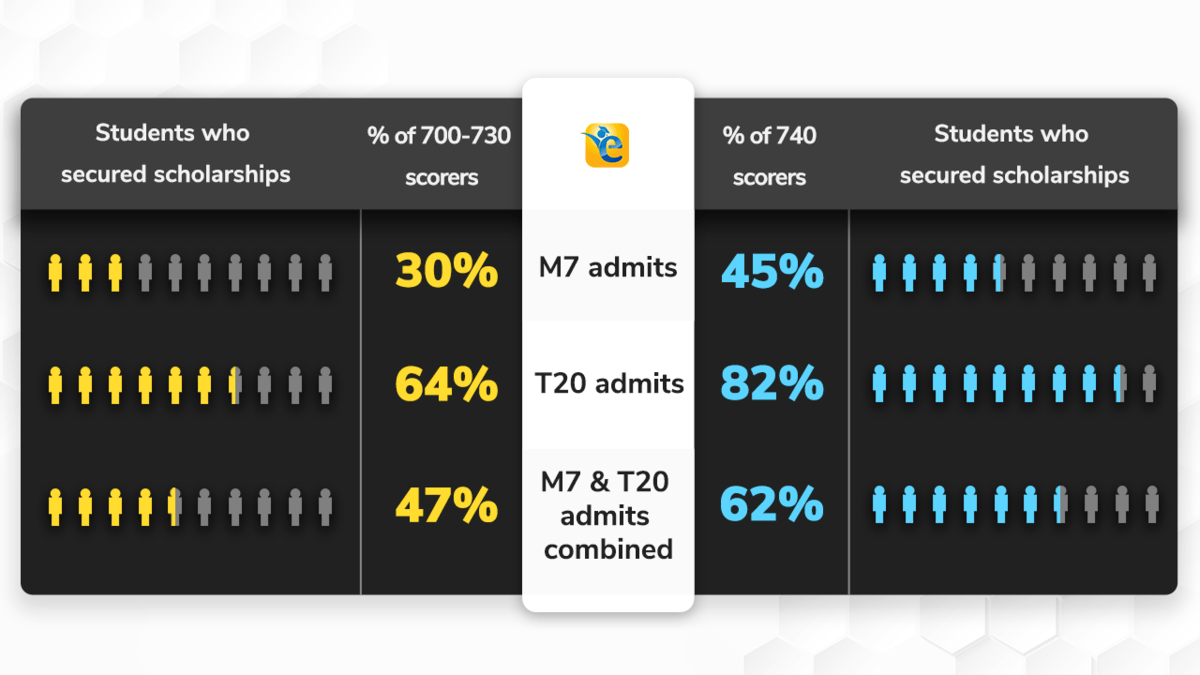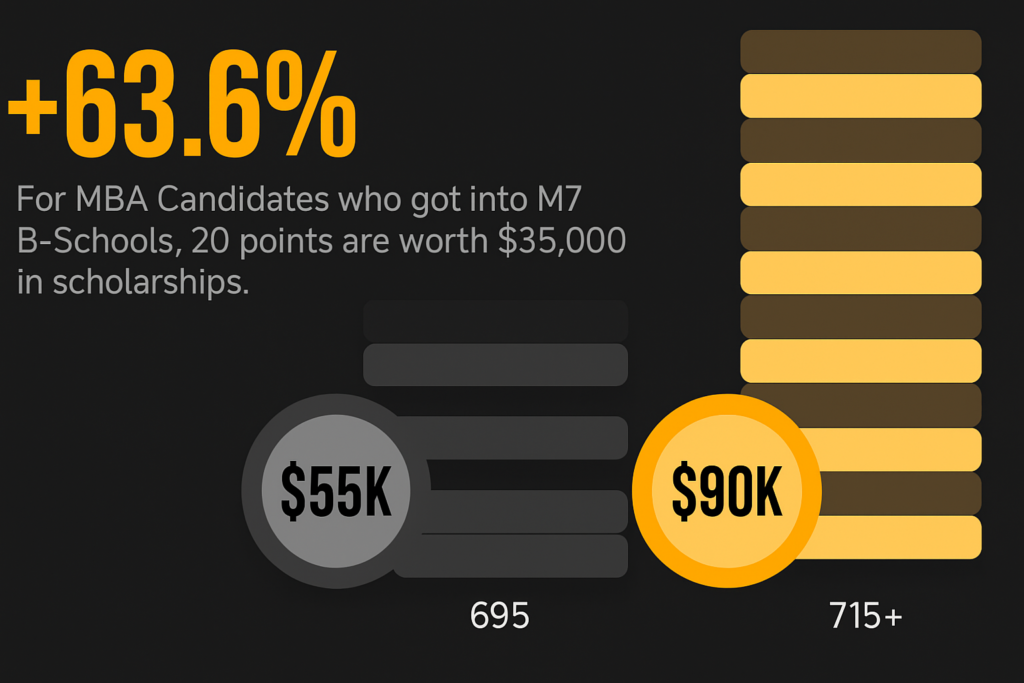While an MBA degree can offer you career growth, better opportunities, and an attractive salary package, it comes with a steep price tag that can cost you as high as $250,000. One way to reduce this financial burden is through loans. However, loans typically charge high-interest rates, take several years to pay back, and sometimes require students to have co-signers in the country of borrowing.
So, what’s the alternative?
The most compelling alternative is the promise of free money in the form of an MBA scholarship. The amount of MBA scholarship can range from $5000 to Free-Ride (Full-Tuition), and it reflects the admissions committee’s willingness to have you join their class instead of a competing school.
But, how would you increase the admissions committee’s willingness to have you join their class? Read this article, highlighting five ingredients to improve your chances of getting that coveted MBA scholarship. These five points are based on the learnings of over 300 e-GMATers who have secured more than $200M in scholarships.

What are the odds of receiving an MBA scholarship?
Generally, 7% or 1 in 8 students have some sort of chance of receiving a scholarship. However, if we dig a bit deeper and look into MBA scholarships for top b-schools, this percentage goes down even more. We estimate that less than 3% of applicants get an MBA scholarship for top b-schools.
Why is it difficult to get a scholarship?
MBA scholarships can be challenging, mainly because the admissions committee uses specific selection criteria for its respective business school. These scholarships are offered based on merit or need. Generally, merit-based scholarships imply that they are rewarded to students who excel at the set parameters of a specific business school. On the other hand, need-based scholarships are rewarded to students who may not be able to support their education financially and need external help in doing so.
What factors do AdComs consider for an MBA scholarship?
The factors that Adcoms look into while evaluating you for an MBA scholarship align with those required to make your MBA profile competitive. Some applicants work on increasing their GMAT score to stand out, while others showcase phenomenal success in their pre-MBA careers. No matter what your unique advantages are, expressing them clearly in your applications makes you more likely to win a scholarship.
So, what are the factors that Adcoms look for?
The Adcoms look into these factors while evaluating your MBA Candidacy/Scholarship:
- Work experience and professional goals
- Leadership
- Creativity and intellectual aptitude
- Interpersonal skills and fit
Here is an article on how an MBA admission committee works.
How to get an MBA Scholarship?
Now that you know the various evaluating factors to secure a scholarship, one pressing question needs to be answered:
With less than 3% of applicants getting MBA scholarships, how can you increase your chances?
To increase your chances of getting an MBA scholarship, you need to:
- Secure a high GMAT score
- Align your post-MBA goals with your profile
- Evaluate your Business school fit
- Apply early
- Negotiate the scholarship amount
Let’s look into each point in detail.
Secure a high GMAT score
After analyzing the MBA journey of 1000s of e-GMATers who have secured admits from M7 or T20 business schools, six out of 10 students who scored 740+ (695 equivalent on the GMAT focus) received some form of scholarship (including many full rides). Moreover, at US Top 20 alone, 8 out of 10 740+ scorers received financial aid. And that’s not all!
The chances of getting a scholarship increase by approx. 21% for M7 and T20 B-schools, when we compare a GMAT 700-730 (655 to 685 on the focus edition) with a 740 scorer (~695 GMAT focus).

What’s even more interesting is that the scholarship amount multiplies with a higher GMAT score. 715+ scorers at M7 schools receive ~$90,000 in average scholarships, much higher than that received by 695-scorers ($55,000).

Thus, we can say that a high GMAT score can increase your chances of getting a scholarship and an admit. But one question still pertains here. Why does the admissions committee look at a high GMAT score as one of the ingredients to secure a scholarship?
A high GMAT score signals to the admissions committee that the candidate:
- Can adapt well to the rigorous MBA curriculum
- Possess exceptional quantitative skills
- Can prioritize effectively
All of these are skills essential to ensure success during and after the MBA program. So, candidates with a higher chance of long-term success are likely to get handsome scholarships. Moreover, high GMAT scores for the incoming class are also a matter of prestige for top business schools and are critical to determining b-school rankings. So, admissions committees are likely to incentivize high GMAT scores to attract top talent to improve rankings and the overall prestige of the program.
Let’s have a look at examples of some e-GMATers who have secured great scholarships through their high GMAT scores:
Aayush Gandhi – From waitlisted at 710 to a 750 + $50k scholarship from Columbia
Aayush Gandhi applied to Michigan Ross with a GMAT 710. Ayush had a brilliant profile, and he was hoping to get an admit. To add to this, Ayush had the best interview possible.
Result – He got waitlisted at Ross for one reason – Low GMAT Score
Ayush decided to re-take the GMAT with the help of e-GMAT this time and successfully scored a GMAT 750, which got him an admit from an M7 B-School (Columbia) and a scholarship of around $50k. Watch Ayush’s journey here:
Nishant Rejected with 690 to full fellowship with 740
Nishant scored a 690 in his third GMAT attempt. He was rejected by every school to which he applied, including Tuck School of Business, Smeal College of Business – Penn State, Eli Broad College of Business, and Rotman School of Management. Moreover, Tuck and Smeal told him explicitly that while they liked his candidacy, they rejected his application because of his GMAT score. Nishant put in extra effort and re-took the GMAT and scored a 740. Even though he applied in the third round, Nishant got a full fellowship from Ohio Fischer with this score.
Watch his video interview here:
Cong Bui – $ 144,000 in fellowship
Cong Bui scored a 760 on his GMAT. He did not just manage to receive a full fellowship from Ohio Fischer ($144,000), but he also received a monthly stipend of $1700. In a way, Cong Bui received money to study at Ohio Fischer.
Read this article that highlights how a GMAT score of 730+ yields an incremental $500k in ROI.
We can help you get a high GMAT score. Our AI-driven online preparation course has delivered 10x 700+ scores than the average GMATClub partner. Take our free trial to experience the difference.
Align your post-MBA goals with your profile
Adcoms are looking for well-rounded candidates who have a well-defined post-MBA goal and understand how an MBA will help them achieve that goal.
So, if you do not clearly establish a connection between – Why do you want to pursue an MBA? How will an MBA help you achieve your post-MBA goals? And how is your post-MBA goal in line with your MBA profile? You will not have a great chance of securing a scholarship.
How to define a clear post-MBA goal?
Through an applicant’s post-MBA goals, Ad-Coms assess whether the applicant has a well-defined plan, is focused on it, and has thought about why they need an MBA in general. Failing to demonstrate the above through applications will showcase that you are unfocused and have not thought about your MBA goals correctly, which translates into one thing – No Scholarship!
So, to create the best possible post-MBA goals, you must provide a coherent narrative that convincingly connects your personal motivations for getting an MBA with your prior experiences, as well as your short and long-term goals after MBA.
Let us look at a case study to understand how one candidate got rejected from 8 b-schools for poorly aligning his Post-MBA goals and how fixing that issue got him 5 admits with $250k in scholarships.
From 8 rejects to 5 admits with $250K scholarship
Coming from an engineering background, Shaarang had an unconventional and impressive work history. After his undergrad, he worked in the investment banking sector and simultaneously started his firm (Codebreak – an analytics start-up that delivered tech-enabled advice to retail investors). After gaining almost three years of experience (Investment banking + Entrepreneurship), he decided to apply to business schools for an MBA. Still, he got rejected from all eight colleges because of one reason – Unaligned Post-MBA goals.
After realizing his mistake, Shaarang rebuilt his profile and got into multiple B-schools with about $250,000 worth of scholarships!
How did he do it?
Shaarang realized that he had made his admissions officer’s life hard by talking about complicated plans that he was not in a good position to achieve. He comes from a tech + entrepreneurial background, and his post-MBA goal was to pursue a career in Private Equity/Venture Capital.
When you look at the employment statistics at any top B-school, only about 2% – 3% of the class goes into this sector. Most of these people typically have an Investment Banking/Venture Capital/Private Equity background pre-MBA. Thus, his goals seemed disjointed.
For his second round of MBA applications, his main goal was Product Management at a large tech company, and his plan B was operations manager. As you can see, Shaarang’s post-MBA goals were much more aligned on his 2nd try compared to his previous attempt.
The result – he was able to get an admit plus scholarship from 5 B-schools, with a $250,000 worth scholarship. Clearly, aligning your post-MBA goals with your profile is crucial when it comes to getting a scholarship.
Watch his interview to get an overall picture of Shaarang’s MBA Journey and how he aligned his post-MBA goals to get a $250,000 worth scholarship:
Articulate your Business School “fit” efficiently
B-School selection is one of the essential steps in every MBA aspirant’s journey and is yet avoided till the last point. If you can articulate your “fit” with the B-school effectively and emphasize why that school is your top choice to Adcoms, the chances are that you will be able to secure a scholarship. Moreover, admissions committee members are likely to jump at the opportunity to admit a perfect “fit” candidate, and to do so; they are likely to offer a generous scholarship amount.
Why? Because B-schools want to maintain their acceptance rate. As the competition among schools for the most qualified students has gone up, scholarships are one way to try and retain the best “fit” candidates, which in turn increases the yield. So, make sure your showcase your “fit” to the Adcoms. Besides, your Business School serves as a launchpad for your career, and thus, it is important to identify how aligned the school is with your post MBA career goals. For example, if your goal is to work at an FMCG company, it is wise to check if it recruits from your selected B-schools. If your goal is to transition into another industry such as marketing or consulting, check the B-school’s job placement and statistics report.
Watch this video of Farman, an Dartmouth Tuck MBA Candidate who talks about the key considerations before selecting a b-school, the mistakes MBA aspirants make during this process, and how targeting the right business school leads to earning a scholarship:
Apply early
The acceptance rate in round 1 is generally high compared to other rounds, and so is the amount of scholarship offered. Over $350 Million in Financial Aid was offered in 2019, and a large chunk of this sum was offered in Round 1. Why?
Scholarship offers are plenty and generous in Round 1 as the entire Financial Aid pool is up for offer. Moreover, in the subsequent rounds, the pool is severely diminished, with practically no Financial Aid available to final round applicants. Additionally, MBA Scholarship dollars are budgeted at the beginning of the year and deplete as the admission rounds progress. So, competing for scholarships is easier early in the admissions cycle – when more scholarship dollars are up for grabs.
Applying in round 1 is also advantageous because it lets the adcoms know that a particular business school is your first preference and shows your serious intent and planning. The result – they could reward you with admission as well as a scholarship.
Note: The chances of admission and scholarship depend not only on which MBA Application Round you apply but also on the quality of the application you come up with. Please read this article where we discuss how you can evaluate which MBA admission round to apply to in 2021.
Received five admits with $250,000 worth scholarship in Round 1
In 2019, Shaarang applied in Round 1 and received five admits and a $250,000 worth scholarship from a US Top 20 B-School. However, in 2018, he had applied to 6 schools in Round 2 and got zero admits.
Indian Engineer gets $500K worth MBA scholarship from 6 B-school
Dhananjaya got an admit from 6 B-schools in Round 1 with approx. $500K worth scholarship. Coming from an over-represented pool of candidates, he had a strong MBA profile, with a GMAT 760. He was confident that to maximize his chances of getting a scholarship applying in Round 1 would benefit. Watch his video interview, where he highlights how applying early to his target B-school helped him to secure scholarships from 6 schools:
Did you know a GMAT score of 695 or higher can increase your chances of getting an admit + scholarship + a better ROI post your MBA? Start your GMAT preparation with the most reviewed GMAT prep company on the GMAT club with more than 2900+ reviews. Why don’t you take a free trial and judge it for yourself? Please write to us at acethegmat@e-gmat.com in case of any queries.
CFA holder receives an admit to Columbia with $80K Scholarship
Ayush Rustagi scored a 760 on the GMAT and secured an $80K merit-based scholarship from Columbia Business school. He had applied to four B-school (Columbia, Wharton, Harvard, and Booth) in Round 1 to maximize his opportunity to get an admit and scholarship. Watch his MBA journey and how he secured an MBA scholarship:
Negotiate the scholarship amount
MBA scholarship offers received early in the admissions cycle can be used to secure or increase the scholarship amounts secured later in the cycle. It is a less-known fact that MBA scholarships are negotiable. How do you negotiate?
The most effective way to negotiate your scholarship funding is to win scholarship awards from your program’s peer schools, with whom they are competing for MBA applicants. As touched upon earlier, schools would hate to lose a “perfect fit” candidate to a competing business school or to damage their acceptance rates and, in turn, their rankings. This provides candidates leverage.
So, you can pursue your target school to offer a scholarship or increase the scholarship amount by disclosing offers received from other programs. Admissions officers are likely to negotiate so that they do not lose a top candidate.
Another way to negotiate for a higher scholarship amount is to convey your unique selling point and any recent profile updates to the university. Most universities will consider your proposal and try to see what best they can offer.
One example among our former eGMATer is an MBA applicant Krishna who got an admit from Georgia Tech and secured a scholarship of $500K. At first, when he had applied for a scholarship, he got a decent amount from Georgia Tech. However, when he calculates the MBA program cost, he realized that he has to take a loan to cover the rest of the MBA cost. He negotiated with the university and conveyed why he deserved to get a full scholarship.
MBA Scholarship: Key Takeaways
Here are key takeaways to increase your chances of getting an MBA scholarship:
- A high GMAT score can increase your chances of getting a scholarship.
- The scholarship amount multiplies with a higher GMAT score.
- Have clarity on your post-MBA goals and communicate the same effect through your MBA application.
- Apply to business schools that are aligned with your post-MBA goals and communicate your business school fit efficiently with the admissions committee.
- Apply early to get more scholarship amount and secure an admit
- Negotiate the scholarship amount by disclosing offers received from another business school.
MBA Scholarship FAQs
Yes, you can. Although scholarship committees do not list a minimum GMAT score to guarantee a scholarship, a high GMAT score only increases your chances of getting one. Learn about what is a good GMAT score to secure an MBA scholarship in 2021.
Yes. An MBA is a significant investment, and a scholarship can significantly help in easing the financial burden. Please take a look at this article where we list down MBA scholarships available for Indian and International students.
Aditya Birla Group Chairman Kumar Mangalam Birla has launched an endowed scholarship program of £15 million to support ten full-time MBA candidates at the London Business School every year. Take a look at this article to know more.














